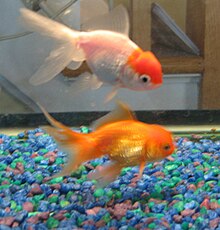
Shubunkins are a hardy, single-tailed goldfish with nacreous scales and a pattern known as calico. The Shubunkins are of Japanese origin.

Calico goldfish are goldfish of any breed that have a type of scale that is intermediate between the metallic type of scales and the transparent type. These scales have a slight sheen that produces a pearly appearance. The name "calico goldfish" came about because the first fish that were introduced with this type of scales had a mottled calico pattern with several colours.

The comet or comet-tailed goldfish is a single-tailed goldfish bred in the United States. It is similar to the common goldfish, except slightly smaller and slimmer, and is mainly distinguished by its long deeply forked tail. Comet goldfish tend to have a diverse variety of colors, unlike the common goldfish.

The telescope, telescope goldfish or telescope eye is a goldfish characterised by its protruding eyes. It was first developed in the early 1700s in China, where the trait was referred to as dragon eyes.

The ryukin is a short deep-bodied fancy goldfish with a characteristic hump in the shoulder region.

The Fantail is a goldfish that possesses an egg-shaped body, a high dorsal fin, a long quadruple caudal fin, and no shoulder hump. It is similar to the Ryukin, and is relatively common in western countries. The Fantail Goldfish is the base for many fancy goldfish species.

The lionhead is a hooded variety of fancy goldfish. This fish is the precursor to the ranchu.
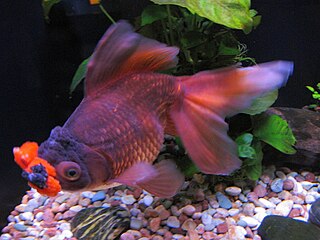
Pompoms, pompon or hana fusa are a type of fancy goldfish that have bundles of loose fleshy outgrowths between the nostrils, on each side of the head.

The Ranchu is a hooded variety of goldfish native to Japan. It is referred to as the "king of goldfish" by the Japanese. Maruko more commonly refers to the egg-fish goldfish.
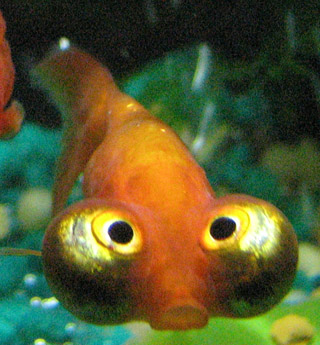
The celestial eye goldfish or Choutengan is a double-tailed breed of fancy goldfish that possesses a distinctive pair of telescope eyes, in which the eyeballs are turned vertically and the pupils appear to be gazing skyward.
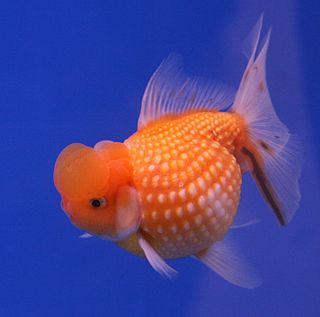
The Pearlscale is a spherical-bodied fancy goldfish with doubled finnage similar to the fantail.

The Lionchu or lionhead-ranchu is a variety of goldfish that has resulted from crossbreeding lionheads and ranchus.
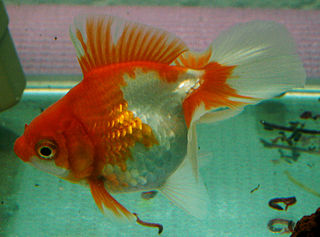
The Tosakin (土佐金) or curly fantail goldfish is a distinctive breed of goldfish with a large tail fin that spreads out horizontally behind the fish. Though technically a divided tail, the two halves are attached at the center, forming a single fin.
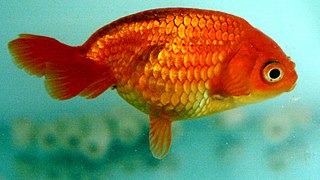
The egg-fish goldfish is a fancy goldfish breed which lacks a dorsal fin and has a pronounced "egg"-shaped body. The egg-fish breed resembles the ranchu, but lacks the "hood" typical of that goldfish; ranchu also tend to have shorter, squatter bodies.

The Curled-gill or Reversed-gill goldfish is another uncommon variety of fancy goldfish that has been developed by specialist enthusiasts. It owes its name from the out-turned appearance of its gill covers. This fish resembles a Ryukin. For the appearance of this goldfish, it has a fantail-shaped body with long finnage all round as well as a deeply forked tail; the color is typically metallic orange.

The goldfish is a freshwater fish in the family Cyprinidae of order Cypriniformes. It is commonly kept as a pet in indoor aquariums, and is one of the most popular aquarium fish. Goldfish released into the wild have become an invasive pest in parts of North America and Australia.

The Shukin is Ranchu-like goldfish developed from Ranchu and Oranda at the end of the 19th century in Japan.
The wakin is an intermediate twin tailed goldfish variety that has been originated from Japan. It is believed the wakin gave rise to fancy twin-tailed goldfish, including the ryukin, ranchu, oranda, fantail pearlscale, and many more twin-tailed goldfish. It is also the second oldest variety, developed from the common goldfish.

The jikin goldfish, also known as the peacock tail goldfish, is a breed of wakin-like goldfish developed in Japan.


